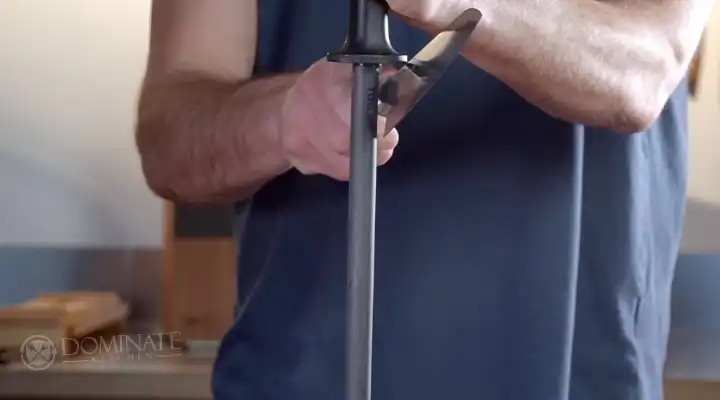How to Sharpen a Kitchen Knife with Rod? Your Kitchen Essentials
A well-sharpened kitchen knife is the cornerstone of any efficient and safe cooking experience. If your knives are losing their edge, don’t rush to a professional sharpener just yet. You can easily maintain your knife’s sharpness using a honing rod, and we’ll guide you through the process. Plus, we’ll share some pro tips to keep your kitchen knives in excellent shape and answer some common questions about knife care.

Sharpening Your Knife with a Rod: Step-by-Step
Let’s gather the necessary tools first.
Materials Needed
A honing rod (sharpening steel)
A kitchen knife in need of sharpening
Inspect the Blade
Examine your knife’s edge. If it’s merely dull and not chipped or damaged, a honing rod is your solution.
Knife Preparation
Wash and dry your knife to remove any food residue and moisture, ensuring a clean surface to work with.
Position the Rod
Hold the honing rod vertically, with its tip resting on a cutting board or a non-slip surface. Make sure it’s at a comfortable height for you.
Holding the Knife
In your dominant hand, grip the knife by the handle, keeping your fingers behind the guard or bolster to avoid accidents.
Maintain Angle
Maintain a consistent angle between the knife edge and the honing rod, usually around 15-20 degrees. Check the manufacturer’s recommendations if available.
Honing Motion
Start with the heel of the knife blade at the top of the rod. With a smooth and controlled motion, draw the knife down the rod towards the tip while maintaining the proper angle. Ensure the entire length of the edge contacts the rod.
Alternate Sides
After each pass on one side, switch to the other and repeat the motion. Aim for about 5-10 strokes per side, or until you sense the blade is adequately honed.
Test the Edge
Check the sharpness of your knife by slicing a piece of paper or a tomato. If you notice a significant improvement, you’ve done a good job.
Clean the Knife
Once honing is complete, wash and dry your knife again to remove any metal shavings that may have accumulated.
Pro Tips to Maintain Knife Quality
Regular Honing: Make honing with a rod part of your routine, either before or after each use, to keep the edge aligned.
Store Properly: Store knives in a knife block, magnetic strip, or blade guards to protect both the edge and prevent accidents.
Cutting Technique: Use appropriate cutting techniques to avoid twisting or prying the knife, as this can damage the blade. Adopt a rocking or slicing motion.
Inspect Periodically: Check for nicks, chips, or bent tips in the blade. Consult a professional if you notice any issues.
Dry Thoroughly: Ensure your knives are completely dry before storing them to prevent rust.
How often should I hone my knives?
Honing is a quick maintenance task and can be done before or after each use.
Can a honing rod replace sharpening with a whetstone or knife sharpener?
No, honing with a rod doesn’t remove material to restore a dull edge. Sharpening is a separate process.
How do I know when it’s time to sharpen my knife?
When honing no longer restores sharpness, or you observe significant dullness, it’s time to sharpen your knife.
What’s the best way to prevent accidents with kitchen knives?
Proper storage, safe cutting techniques, and keeping fingers away from the blade are essential. Knife guards or sheaths add extra safety.
By following these guidelines and pro tips, you can easily maintain your kitchen knives’ sharpness and ensure they serve you well in your cooking journeys for years to come.






